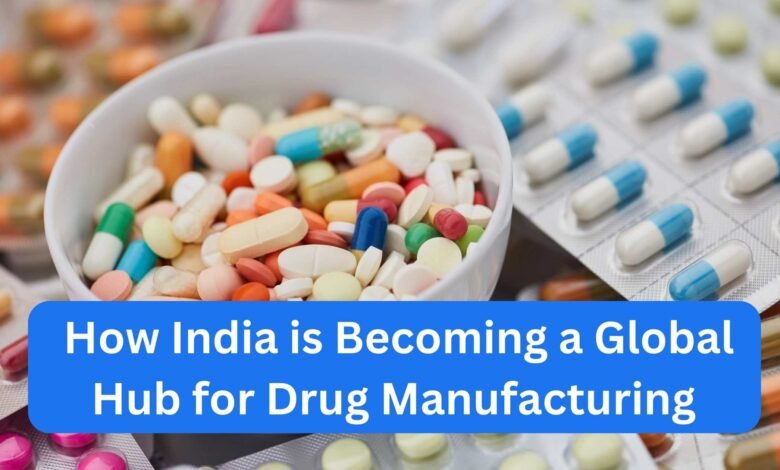How India is Becoming a Global Hub for Drug Manufacturing
The Indian pharmaceutical industry has evolved into a global hub for drug manufacturing

India has earned the title of the “Pharmacy of the World” for a reason. It is one of the largest producers of generic medicines and vaccines, catering to over 50% of global demand. Over the years, the Indian pharmaceutical industry has evolved into a global hub for drug manufacturing, supported by a mix of innovative policies, skilled manpower, and a robust regulatory framework.
In this blog, we’ll explore the factors driving India’s growth in this sector and highlight the processes involved, such as obtaining a manufacturing drug license, No Objection Certificates (NOCs) from the Assistant Drug Controller, and different types of drug licenses like retail and wholesale.
Why India is Leading in Drug Manufacturing
India’s rise as a leader in drug manufacturing can be attributed to several factors:
- Cost-Effective Production: India offers high-quality drugs at much lower costs compared to developed countries. This is due to affordable labor, advanced infrastructure, and economies of scale.
- Robust Regulatory Framework: Organizations like the Central Drugs Standard Control Organization (CDSCO) ensure the quality, safety, and efficacy of drugs manufactured in India. Obtaining certifications and licenses, such as a manufacturing drug license or a retail drug license, ensures compliance with global standards.
- Skilled Workforce: India boasts a large pool of scientists, researchers, and skilled workers contributing to innovation and efficient production.
- Government Support: Initiatives like “Make in India” and Production Linked Incentive (PLI) schemes promote investment and innovation in the pharmaceutical sector.
- Global Demand: India’s capability to produce generic drugs and vaccines at scale has made it indispensable for global healthcare systems, especially during crises like the COVID-19 pandemic.
Understanding the Licensing Process
Licensing is a critical aspect of drug manufacturing. Here’s an overview of the key licenses required in India:
1. Manufacturing Drug License
To manufacture drugs in India, a manufacturing drug license is mandatory. This license is issued by the State Drug Control Authority under the Drugs and Cosmetics Act, 1940.
- Application Process:
Applicants need to submit detailed information, including the location of the manufacturing unit, the equipment used, and the qualifications of the personnel involved.
- NOC from Assistant Drug Controller:
ADC NOC is often required for manufacturing certain categories of drugs. This ensures that the product complies with safety and quality standards.
- Compliance Requirements:
Manufacturers must adhere to Good Manufacturing Practices (GMP) and other regulatory standards to maintain quality.
2. Retail Drug License
A retail drug license is required for pharmacies or outlets selling drugs directly to consumers.
- Eligibility:
The licensee must have a qualified pharmacist to oversee operations.
- Application Process:
Applications must include the pharmacist’s registration certificate, proof of premises, and other supporting documents.
3. Wholesale Drug License
This wholesale drug license is necessary for businesses that supply drugs in bulk to retailers or other distributors.
- Eligibility:
Applicants must have a minimum area of 10 square meters for the premises and appoint a competent person, such as a registered pharmacist or someone with a degree in pharmaceuticals.
- Application Process:
Similar to the retail license, but with additional requirements related to bulk handling and storage.
India’s Regulatory Edge
The CDSCO and state drug controllers work in tandem to regulate drug manufacturing and distribution. This dual system ensures that:
- Drugs meet international standards.
- Manufacturers comply with Good Laboratory Practices (GLP) and GMP.
- Counterfeit drugs are minimized through strict monitoring.
Challenges and How India Overcomes Them
While India has made significant progress, the journey hasn’t been without challenges:
- Regulatory Hurdles:
Navigating through licensing requirements, such as obtaining an NOC from the Assistant Drug Controller, can be time-consuming. The government is working on digitizing and streamlining these processes.
- Quality Concerns:
Ensuring consistent quality across manufacturers is challenging. Continuous monitoring and mandatory compliance with GMP have addressed this issue to a large extent.
- Competition:
Other countries like China pose stiff competition. However, India’s strong regulatory framework and ability to scale operations give it a competitive edge.
Future Prospects
India’s drug manufacturing sector is set to grow even further. Some key trends to watch include:
- Biopharmaceuticals: A focus on research and production of biologics, biosimilars, and advanced therapies.
- Digital Transformation: The adoption of AI, IoT, and blockchain to improve efficiency and traceability in manufacturing.
- Global Expansion: Indian pharmaceutical companies are expanding their footprints in markets like Africa, Latin America, and Europe.
Conclusion
India’s journey to becoming a global hub for drug manufacturing is a testament to its resilience, innovation, and commitment to quality. With continued support from the government, advancements in technology, and adherence to stringent regulatory standards, India is poised to lead the global pharmaceutical industry.
For entrepreneurs and businesses looking to enter this field, understanding the licensing processes—such as obtaining a manufacturing drug license, retail drug license, or wholesale drug license—is crucial. With proper planning and compliance, India’s pharmaceutical sector offers immense opportunities for growth and success.


